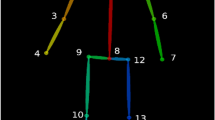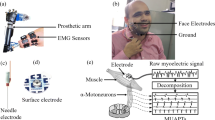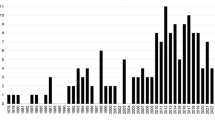Abstract
In the present work, decision trees are employed to determine the activation patterns in electromyographic signals in multiple muscles of interest. Due to the interaction of several muscles when performing a movement, it is common for several muscles to activate simultaneously. The problem is to determine if any muscle of interest is active and, in the case of multiple active muscles, which of them is the predominant one. In turn, we are interested in determining if a muscle is active enough to associate it with a voluntary movement. The proposed scheme is based on decision trees (which are supervised learning strategies for classification), and the envelope of a signal as a classification feature. The detection of an activation is performed in two stages: the first stage determines the candidate muscle to be active and a second stage determines its activation level. The algorithm was tested in control of a robotic arm in real time. The activation of a muscle is associated with a control command of a DC motor of the robotic arm. The proposed algorithm made it possible to manipulate the movements of that robotic arm to perform a simple task using electromyographic signals.












Similar content being viewed by others
Data availability
Data available upon reasonable request from the corresponding author (J.E.M.-D.)
References
Mills KR (2005) The basics of electromyography. J Neurol Neurosurg Psychiatry 76(suppl 2):32–35
Gila L, Malanda A, Rodríguez Carreño I, Rodríguez Falces J, Navallas J (2009) Métodos de procesamiento y análisis de señales electromiográficas. In: Anales del Sistema Sanitario de Navarra, vol 32. SciELO Espana, pp 27–43
Chávez LAV, Hernández JML, Arenas FJR, Navarrete AAF (2020) EMGs signal acquisition and filtering. Pistas Educativas 42(137):66
Gupta V, Suryanarayanan S, Reddy NP (1997) Fractal analysis of surface EMG signals from the biceps. Int J Med Inform 45(3):185–192
Cornwell AS (2012) Control of a multiple degree-of-freedom arm with functional electrical stimulation using a reduced set of command inputs. Case Western Reserve University, Ohio
Sadikoglu F, Kavalcioglu C, Dagman B (2017) Electromyogram (EMG) signal detection, classification of EMG signals and diagnosis of neuropathy muscle disease. Procedia Comput Sci 120:422–429
Disselhorst-Klug C, Schwartz M (2012) Non-invasive diagnosis of neuromuscular disorders by high-spatial-resolution-EMG. In: EMG methods for evaluating muscle and nerve function. InTech, pp 227–240
Zhuang KZ, Sommer N, Mendez V, Aryan S, Formento E, D’Anna E, Artoni F, Petrini F, Granata G, Cannaviello G et al (2019) Shared human-robot proportional control of a dexterous myoelectric prosthesis. Nat Mach Intell 1(9):400–411
Togo S, Matsumoto K, Kimizuka S, Jiang Y, Yokoi H (2021) Semi-automated control system for reaching movements in EMG shoulder disarticulation prosthesis based on mixed reality device. IEEE Open J Eng Med Biol 2:55–64
Mokri C, Bamdad M, Abolghasemi V (2022) Muscle force estimation from lower limb EMG signals using novel optimised machine learning techniques. Med Biol Eng Comput 60(3):683–699
Kokol P (2002) Proceedings of the 15th IEEE symposium on computer-based medical systems (CBMS 2002), 4–7 June, 2002, Maribor, Slovenia
Paul Y, Goyal V, Jaswal RA (2017) Comparative analysis between SVM & KNN classifier for EMG signal classification on elementary time domain features. In: 2017 4th International conference on signal processing, computing and control (ISPCC). IEEE, pp 169–175
Yousefi J, Hamilton-Wright A (2014) Characterizing EMG data using machine-learning tools. Comput Biol Med 51:1–13
Durán Acevedo CM, Jaimes Mogollón AL (2013) Optimización y clasificación de señales EMG a través de métodos de reconocimiento de patrones. Iteckne 10(1):67–76
Borg F, Finell M, Hakala I, Herrala M (2007) Analyzing gastrocnemius EMG-activity and sway data from quiet and perturbed standing. J Electromyogr Kinesiol 17(5):622–634
Yousefi J, Hamilton-Wright A (2014) Characterizing EMG data using machine-learning tools. Comput Biol Med 51:1–13
Tomasiello S (2011) A functional network to predict fresh and hardened properties of self-compacting concretes. Int J Numer Methods Biomed Eng 27(6):840–847
Tomasiello S (2020) Least-squares fuzzy transforms and autoencoders: some remarks and application. IEEE Trans Fuzzy Syst 29(1):129–136
Tomasiello S, Pedrycz W, Loia V (2022) On fractional tikhonov regularization: application to the adaptive network-based fuzzy inference system for regression problems. IEEE Trans Fuzzy Syst 6:66
Tomasiello S, Gaeta M, Loia V (2016) Quasi-consensus in second-order multi-agent systems with sampled data through fuzzy transform. J Uncertain Syst 10(4):243–250
Phinyomark A, Quaine F, Charbonnier S, Serviere C, Tarpin-Bernard F, Laurillau Y (2014) Feature extraction of the first difference of EMG time series for EMG pattern recognition. Comput Methods Prog Biomed 117(2):247–256
Furui A, Igaue T, Tsuji T (2021) EMG pattern recognition via Bayesian inference with scale mixture-based stochastic generative models. Expert Syst Appl 185:115644
Tsuji T, Fukuda O, Kaneko M, Ito K (2000) Pattern classification of time-series EMG signals using neural networks. Int J Adapt Control Signal Process 14(8):829–848
Guerrero JA, Castillo-Galván MA, Macías-Díaz JE (2018) Novel electromyography signal envelopes based on binary segmentation. Biomed Signal Process Control 45:225–236
Wang F, Lu J, Fan Z, Ren C, Geng X (2022) Continuous motion estimation of lower limbs based on deep belief networks and random forest. Rev Sci Instrum 93(4):044106
Chen M, Liu H (2020) Robot arm control method using forearm EMG signals. In: MATEC Web of conferences, vol 309. EDP Sciences, p 04007
Chen X, Ke A, Ma X, He J (2016) SoC-based architecture for robotic prosthetics control using surface electromyography. In: 2016 8th International conference on intelligent human-machine systems and cybernetics (IHMSC), vol 1. IEEE, pp 134–137
Gauthaam M, Kumar SS (2011) EMG controlled bionic arm. In: 2011 National conference on innovations in emerging technology. IEEE, pp 111–114
Hu P, Li S, Chen X, Zhang D, Zhu X (2010) A continuous control scheme for multifunctional robotic arm with surface EMG signal. In: International conference on intelligent robotics and applications. Springer, pp 81–91
Kotlyarevskaya MV, Zhilenkov AA, Slepova LO (2018) Control of an actuator in the motion prosthetics device by signals of biological nervous system. In: 2018 IEEE conference of Russian young researchers in electrical and electronic engineering (EIConRus). IEEE, pp 894–897
Suberbiola A, Zulueta E, Lopez-Guede JM, Etxeberria-Agiriano I, Graña M (2015) Arm orthosis/prosthesis movement control based on surface EMG signal extraction. Int J Neural Syst 25(03):1550009
Guerrero J, Macías-Díaz JE (2019) An optimal Bayesian threshold method for onset detection in electric biosignals. Math Biosci 309:12–22
Guerrero JA, Macías-Díaz JE (2020) A threshold selection criterion based on the number of runs for the detection of bursts in EMG signals. Biomed Signal Process Control 57:101699
Moret BM (1982) Decision trees and diagrams. ACM Comput Surv 14(4):593–623
Quinlan JR (1986) Induction of decision trees. Mach Learn 1:81–106
Therneau T, Atkinson B (2019) Rpart: recursive partitioning and regression trees. R package version 4.1-15. https://CRAN.R-project.org/package=rpart
Acknowledgements
The authors wish to thank the associate editor in charge of handling this paper as well as the anonymous reviewers, for the time and efforts reviewing this manuscript. Thanks to their constructive criticisms and suggestions, this work was improved substantially.
Author information
Authors and Affiliations
Contributions
The authors contributed equally to the work.
Corresponding author
Ethics declarations
Conflict of interest
The authors declare that they have no conflict of interest.
Funding
The corresponding author (J.E.M.-D.) acknowledges the financial support from the National Council of Science and Technology of Mexico (CONACYT) through grant A1-S-45928.
Code availability
Code available on request from the corresponding author.
Additional information
Publisher's Note
Springer Nature remains neutral with regard to jurisdictional claims in published maps and institutional affiliations.
Rights and permissions
Springer Nature or its licensor (e.g. a society or other partner) holds exclusive rights to this article under a publishing agreement with the author(s) or other rightsholder(s); author self-archiving of the accepted manuscript version of this article is solely governed by the terms of such publishing agreement and applicable law.
About this article
Cite this article
Ramírez-Pérez, V., Guerrero-Díaz-de-León, J.A. & Macías-Díaz, J.E. On the detection of activity patterns in electromyographic signals via decision trees. Evol. Intel. 17, 577–588 (2024). https://doi.org/10.1007/s12065-023-00844-0
Received:
Revised:
Accepted:
Published:
Issue Date:
DOI: https://doi.org/10.1007/s12065-023-00844-0




